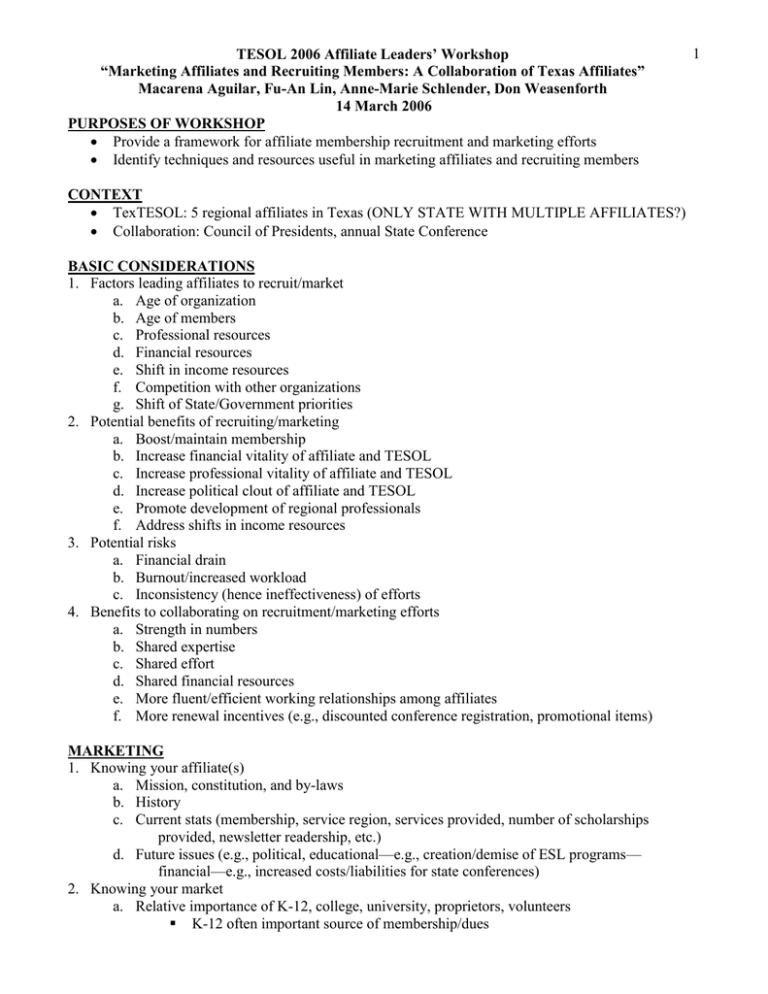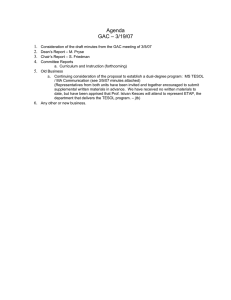TESOL 2006 Affiliate Leaders’ Workshop 1
advertisement

TESOL 2006 Affiliate Leaders’ Workshop “Marketing Affiliates and Recruiting Members: A Collaboration of Texas Affiliates” Macarena Aguilar, Fu-An Lin, Anne-Marie Schlender, Don Weasenforth 14 March 2006 PURPOSES OF WORKSHOP Provide a framework for affiliate membership recruitment and marketing efforts Identify techniques and resources useful in marketing affiliates and recruiting members CONTEXT TexTESOL: 5 regional affiliates in Texas (ONLY STATE WITH MULTIPLE AFFILIATES?) Collaboration: Council of Presidents, annual State Conference BASIC CONSIDERATIONS 1. Factors leading affiliates to recruit/market a. Age of organization b. Age of members c. Professional resources d. Financial resources e. Shift in income resources f. Competition with other organizations g. Shift of State/Government priorities 2. Potential benefits of recruiting/marketing a. Boost/maintain membership b. Increase financial vitality of affiliate and TESOL c. Increase professional vitality of affiliate and TESOL d. Increase political clout of affiliate and TESOL e. Promote development of regional professionals f. Address shifts in income resources 3. Potential risks a. Financial drain b. Burnout/increased workload c. Inconsistency (hence ineffectiveness) of efforts 4. Benefits to collaborating on recruitment/marketing efforts a. Strength in numbers b. Shared expertise c. Shared effort d. Shared financial resources e. More fluent/efficient working relationships among affiliates f. More renewal incentives (e.g., discounted conference registration, promotional items) MARKETING 1. Knowing your affiliate(s) a. Mission, constitution, and by-laws b. History c. Current stats (membership, service region, services provided, number of scholarships provided, newsletter readership, etc.) d. Future issues (e.g., political, educational—e.g., creation/demise of ESL programs— financial—e.g., increased costs/liabilities for state conferences) 2. Knowing your market a. Relative importance of K-12, college, university, proprietors, volunteers K-12 often important source of membership/dues 1 2 TESOL 2006 Affiliate Leaders’ Workshop “Marketing Affiliates and Recruiting Members: A Collaboration of Texas Affiliates” Macarena Aguilar, Fu-An Lin, Anne-Marie Schlender, Don Weasenforth 14 March 2006 Colleges/universities often important source of professional development b. Regional variations c. Current issues of concern to each market entity d. Professional development needs e. Interested constituents 3. Choosing appropriate promotional tools a. Mailings (letters, forms, postcards) Reduced mailing rates for non-profit organizations Bulk mailings http://www.usps.com/businessmail101/getstarted/bulkMail.htm Direct Mail http://www.usps.com/directmail/ Postcards http://www.usps.com/netpost/reachcustomers.htm b. Tax-exempt status (501.c.3 for US affiliates) Benefits: reduced costs for postage and convention costs Lobbying laws for tax-exempt organizations IRS web site http://www.irs.gov/charities/article/0,,id=96122,00.html c. Mailing lists Reciprocal exchange of mailing lists d. Emails/Personal calls e. Web site Link between affiliate and TESOL web sites f. TESOL Affiliate Profile program g. Brochures Announce/provide: mission statement, services, programs, application form Posting and announcing online application form h. Membership information/forms in publications i. Public service announcements j. Directories (programs and membership) k. Contacting organizations of interest Colleges/universities (IEPs, English departments, Education departments, modern language departments) Private language schools Public/independent school districts (teachers, supervisors, principals) Community/adult education programs Language associations Government agencies MEMBERSHIP RECRUITMENT 1. Creating database for quick, personal contact 2. Cultivating relationships with key decision makers in organizations of interests (see list of list of possible contacts under 3k above) 3. Running recruitment drives a. Take advantage of collaborative effort among affiliates b. Provide free membership for bringing in a certain number of new members c. Offer institutional memberships d. Offer reduced fees for 2- or 3-year memberships e. Offer lower first-year dues for new members f. Offer membership incentives g. Schedule membership drive to coincide with annual conference 3 TESOL 2006 Affiliate Leaders’ Workshop “Marketing Affiliates and Recruiting Members: A Collaboration of Texas Affiliates” Macarena Aguilar, Fu-An Lin, Anne-Marie Schlender, Don Weasenforth 14 March 2006 Include membership information in conference registration materials Include membership fee in conference registration fee h. Hosting a mini conference that includes a membership drive i. Sending mailings to heads of schools at different levels to make them aware of our activities 4. Creating a “sense of belonging/ownership” a. Introduce new members incrementally b. Advocate for members/potential members c. Provide services Administer surveys to assess needs (collect at conferences/mail/post online) Promote awards and scholarships Provide (mini-)workshops in addition to conference(s) Offer discounts on conference fees Hold newcomer session and/or have newcomer hospitality booth at conferences; include newcomer packet at both Promote “Best of Sessions” access to State & TESOL conferences Offer directories (programs and/or membership) Establish blogs/wiki/listserv for feedback 5. Publish affiliate journal/state conference proceedings 6. Announce upcoming conferences through TESOL Central Office and publications TESOL Worldwide Calendar of Events: contact Valerie Borchelt at vborchelt@tesol.org Advertising in TESOL publication http://www.tesol.org/s_tesol/seccss.asp?CID=153&DID=1623 7. Take advantage of TESOL/Affiliate Assembly resources 8. Collaborate with other organizations (e.g., BEAM, TABE/NABE, TADE/NADE, SCMLA/MLA, SOCALLT/IALLT, CALICO, FLESA, NAFSA, schools, colleges, universities) 9. Work with affiliates’ Council of Presidents 10. Establish formal agreement through TESOL 11. Designate (collaborative) membership coordinator 12. Establish a chapter in more remote/less active areas 13. Keep members once you have them (e.g. Rossel & Whelan, 2004) Advertise renewals in newsletter and include renewal form Mail/Email reminders Include expiration dates on mailings
